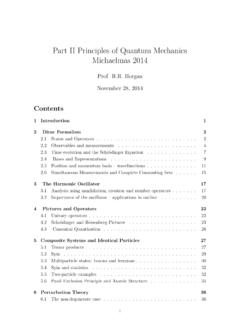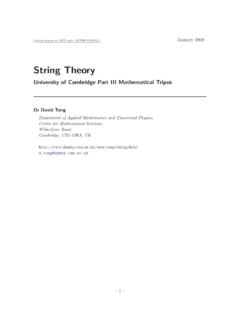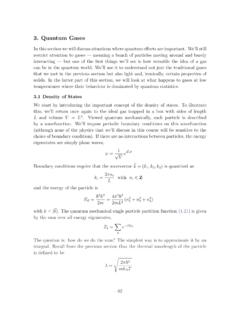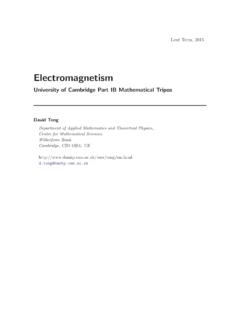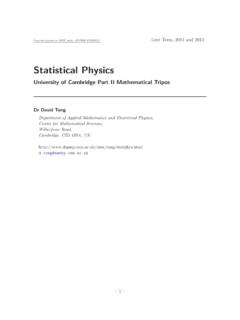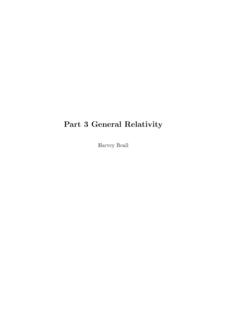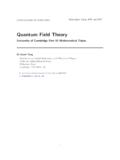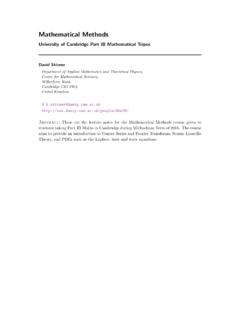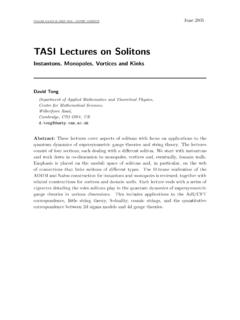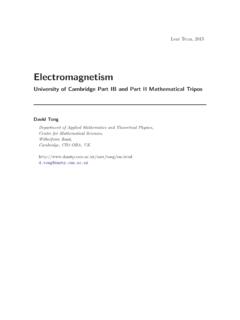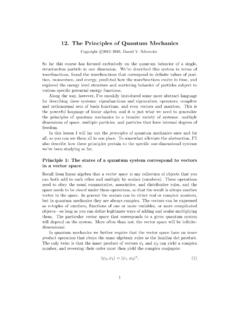Transcription of Principles of Quantum Mechanics - DAMTP
1 Principles of Quantum MechanicsUniversity of Cambridge Part II Mathematical TriposDavid SkinnerDepartment of Applied Mathematics and Theoretical Physics,Centre for Mathematical Sciences,Wilberforce Road,Cambridge CB3 0 WAUnited are the lecture notes for the Principles of Quantum Mechanics coursegiven to students taking Part II Maths in Cambridge during Michaelmas Term of main aim is to discuss Quantum Mechanics in the framework of Hilbert space, followingDirac. Along the way, we talk about transformations and symmetries, angular momentum,composite systems, dynamical symmetries, perturbation theory (both time independentand time dependent, degenerate and non degenerate). We ll finish with a discussion ofvarious interpretations of Quantum Mechanics , entanglement and Introduction12 Hilbert Definition of Hilbert Dual Dirac Notation and Continuum Postulates of Quantum Mechanics133 The Harmonic Raising and Lowering Dynamics of Anharmonic Oscillations204 Transformations and Transformations of States and Translations Around a Time The Heisenberg Symmetries and Conservation Parity425 Angular Angular Momentum Large Rotation of Diatomic Intrinsic The Stern Gerlach Spin Nuclear Magnetic Orbital Angular Wavefunctions for orbital angular momentum eigenstates60 i 6 Dynamical The Isotropic Harmonic Oscillator ind= Enhanced Symmetry of the Isotropic Angular momentum of the harmonic The Hydrogen The Quantum Runge Lenz Angular momentum in Hydrogen727 Composite The Tensor Product of Hilbert Addition of Angular Momenta(A Little More Representation Theory)
2 0= 12=1 1 12=32 The Classical Identical Pauli s Exclusion The Periodic Intrinsic Parities and Decay Processes918 Perturbation Theory I: Time Independent An Analytic Fine Structure of The Ground State of The quadratic Stark E Degenerate Perturbation The linear Stark E Validity of Perturbation Theory1089 Perturbation Theory II: Time Dependent The Interaction Fermi s Golden Ionization by Monochromatic Randomly Fluctuating Emission and Absorption of Einstein s Statistical Selection Rules12310 Interpreting Quantum The Density Reduced density Measurement in Quantum Mechanics133 ii The EPR Bell s Inequality134 iii AcknowledgmentsNothing in these lecture notes is original. In particular, my treatment is heavily influencedby the textbooks listed below, especially Weinberg sLectures on Quantum Mechanics ,Hall sQuantum Theory for Mathematiciansand Binney & Skinner sThe Physics of Quan-tum Mechanics (though I feel more justified in plagiarising this one).
3 I ve also borrowedfrom previous versions of the lecture notes for this course, by Profs. R. Horgan and , which are available am supported by the European Union under an FP7 Marie Curie Career IntegrationGrant. iv PreliminariesThese are the notes for the Part II course on Principles of Quantum Mechanics o ered inPart II of the Maths Tripos, so I ll feel free to assume you took the IB courses onQuantumMechanics,MethodsandLinear Algebralast year. For Part II, I d expect the materialpresented here to complement the courses onClassical Dynamics,Statistical PhysicsandperhapsIntegrable Systemsvery well on the Applied side, in addition to being a prerequisiteforApplications of Quantum Mechanicsnext term. On the pure side, the coursesLinearAnalysisorFunctional AnalysisandRepresentation Theoryare probably the most closelyrelated to this & Other ResourcesThere are many textbooks and reference books available on Quantum Mechanics .
4 Di erentones emphasise di erent aspects of the theory, or di erent applications in physics, or giveprominence to di erent mathematical structures. QM is such a huge subject nowadaysthat it is probably impossible for a single textbook to give an encyclopaedic treatment(andabsolutelyimpossible for me to do so in a course of 24 lectures). Here are some of theones I ve found useful while preparing these notes; you might prefer di erent ones to me. Weinberg, on Quantum Mechanics , CUP (2013).This is perhaps the single most appropriate book for the course. Written by one ofthe great physicists of our times, this book contains a wealth of information. Highlyrecommended. Binney, and Skinner, Physics of Quantum Mechanics , OUP (2014).The number 1 international Contains a much fuller version of these notes(with better diagrams!). Put it on your Christmas list. Dirac, of Quantum Mechanics , OUP (1967).The notes from an earlier version of this course!
5 Written with exceptional clarityand insight, this is a genuine classic of theoretical physics by one of the founders ofQuantum Mechanics . Shankar, Mehanics,A much-loved textbook, with particular emphasis on the physical applications ofquantum Mechanics . Hall, Theory for Mathematicians, Springer (2013).If you re more interested in the functional analysis & representation theory aspectsof QM rather than the physical applications, this could be the book for you. Muchof it is at a more advanced level than we ll need. Sakurai, Quantum Mechanics , Addison Wesley (1994).By now, another classic book on QM, presented from a perspective very close to thiscourse. v Townsend, Modern to Approach to Quantum Mechanics ,2ndedition, Univer-sity Science Books (2012).Very accessible, but also fairly comprehensive textbook on QM. Starts by consideringspin-12particle as a simple example of a two state are expensive, so check what s available in your college library before shellingout any reasonably modern textbook on QM will be adequate for this course.
6 There arealso lots of excellent resources available freely online, including these: Hereare the lecture notes from last year s course. Hereare the lecture notes from several years ago. Hereare the lecture notes from the Part II Further Quantum Mechanics course inthe Cavendish. Theseare the lecture notes from Prof. W. Taylor s graduate course on QM at first half of his course covers material that is relevant here, while scatteringtheory will be covered in next term s Applications of Quantum Mechanics Part IIcourse. Thisis the lecture course on Quantum Mechanics from Prof. R. Fitzpatrick at theUniversity of Texas, Austin. vi 1 IntroductionIn classical Mechanics , a particle s motion is governed by Newton s Laws. These are secondorder , so to determine the fate of our particle we must specify two initial could take these to be the particle s initial positionx(t0) and velocityv(t0), or it s initialpositionx(t0) and momentump(t0).
7 Once these are specified the motion is determined(provided of course we understand how to describe the forces that are acting). This meansthat we can solve Newton s Second Law to find the values (x(t),p(t)) fort>t01. So as timepasses, our classical particle traces out a trajectory in the spaceMof possible positionsand momenta, sketched in figure1. The spaceMis known asphase spaceand in our case,for motion in three dimensions,Mis justR6. In generalMcomes with a rich geometryknown as aPoisson structure; you ll study this structure in detail if you re taking the PartII courses on Classical Dynamics or Integrable Systems, and we ll touch on it later in thiscourse, observables are represented by functionsf:M!Rf:(x,p)7!f(x,p).For example, we may be interested in the kinetic energyT=p2/2m, potential energyV(x), angular momentumL=x p, or a host of other possible quantities. A priori,these functions are defined everywhere overM, but if we want to know about the energyor angular momentum ofour specific particlethen we should evaluate them not at somerandom point (x,p)2M,butalong the particle s phase space trajectory.
8 For example, ifat timetthe particle has positionx(t) and momentump(t), then its angular momentumisx(t) p(t). Thus the values of the particle s energy, angular on time, though of course ourdefinitionof these quantities does ,1We can certainly do this numerically, at least fortin a su ciently small open subset ch n i c a l l y, we t a ke t h e p u l l b a ck o ffby the embedding map :[t0,1)! +++(x0,p0)(x(t),p(t))R2dRfFigure 1:A particle s trajectory in phase space. Observables are represented by functionsf:R2d!R, evaluated along a given particle s trajectory. 1 everything we could possibly want to know about a single, pointlike particle is encoded inits phase space that is not our World. To the best of our current experimental knowledge, ourWorld is a Quantum , not classical, one. Initially, these experiments were based on carefulstudies of atomic spectroscopy and blackbody radiation, but nowadays I d prefer to saythat the best evidence of Quantum Mechanics is simply that we use it constantly in oureveryday lives.]
9 Each time you listen to music on your stereo, post a photo on Instagram ormake a call on your smartphone you re relying on technology that s only become possibledue to our understanding of the Quantum structure of matter. Whenever you plug some-thing into the mains, you re using electricity that s in part generated by nuclear reactionsin which Quantum Mechanics is essential, while much of modern medicine relies on newdrugs designed with the benefit of the improved understanding of chemistry that quantummechanics such a Quantum world, instead of a phase space trajectory, everything we could wantto know about a particle is encoded in a vector in Hilbert spaceH. As you met in IBQuantum Mechanics , thisstate vectorevolves in time according to Schr odinger s the Quantum world, observables are represented by certain operatorsO. The operatorsyou saw in IB QM had the same sort of form as observables classical Mechanics , such as thekinetic energy operator T= p2/2mor angular momentum operator L= x p.
10 However,rather than being functions, these operators are (roughly) linear mapsO:H! , in the first instance these operators are defined throughoutH,butifwe reinterestedin knowing about the energy or angular momentum of our particular Quantum particle,then we should find out what happens when they act on the specific 2 Hthat describesthe state of our particle at timet. (See figure2.)zxy +++(x0,p0)(x(t),p(t))R2dRfH =O OFigure 2:In Quantum Mechanics , complete knowledge of a particle s states is determinedby a vector in Hilbert space. Observables are represented by Hermitian linear operatorsO:H!H. 2 In the following chapters we ll study what Hilbert space is and what it s operatorsdo in a more general framework than you saw last year, building your insight into themathematical structure of Quantum Mechanics . Much of this is just linear algebra, butthe Hilbert spaces we ll care about in QM are often infinite-dimensional, so we also makecontact with Functional Analysis.
